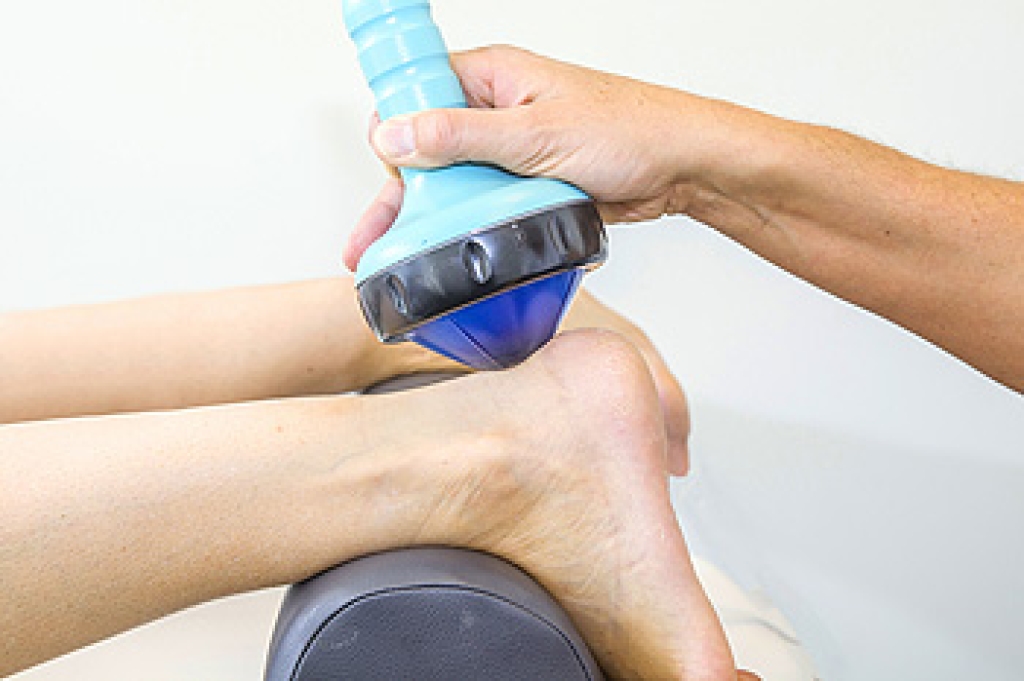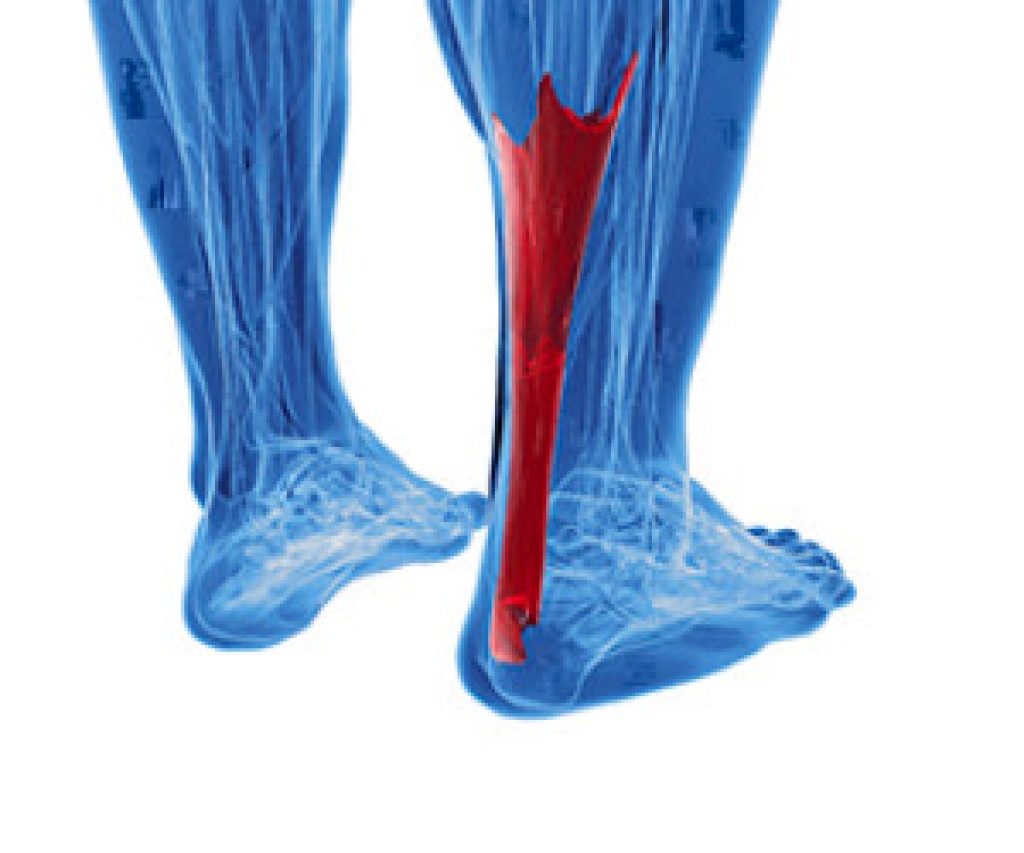
Lansdowne, PA
(610) 626-3338

Lansdowne, PA
(610) 626-3338
 Extracorporeal Shockwave Therapy (ESWT) is a non-surgical procedure that can be used to treat plantar fasciitis, a common foot problem that can cause heel and arch pain. Many cases of plantar fasciitis respond to more conservative treatment such as activity and footwear modifications. However, in some cases plantar fasciitis pain persists and requires more intensive intervention. ESWT can help. During this procedure, a wave of sound energy is delivered into the affected foot to stimulate blood flow and the release of inflammatory mediators. This is thought to help heal the area and reduce or relieve the symptoms of plantar fasciitis. If you have chronic plantar fasciitis that is not responding to other treatments, consult with your podiatrist whether ESWT may be an option for you.
Extracorporeal Shockwave Therapy (ESWT) is a non-surgical procedure that can be used to treat plantar fasciitis, a common foot problem that can cause heel and arch pain. Many cases of plantar fasciitis respond to more conservative treatment such as activity and footwear modifications. However, in some cases plantar fasciitis pain persists and requires more intensive intervention. ESWT can help. During this procedure, a wave of sound energy is delivered into the affected foot to stimulate blood flow and the release of inflammatory mediators. This is thought to help heal the area and reduce or relieve the symptoms of plantar fasciitis. If you have chronic plantar fasciitis that is not responding to other treatments, consult with your podiatrist whether ESWT may be an option for you.
Shockwave therapy is a treatment commonly used to treat various injuries and conditions, particularly plantar fasciitis in the feet. To learn more, consult with Dr. George Yarnell from Pennsylvania. Our doctor can provide the care you need to keep you pain-free and on your feet.
Shockwave Therapy
Shockwave therapy is a new treatment option designed to treat bone conditions such as tennis elbow, shoulder pain, and others. Shockwave therapy uses high intensity sound waves that are directed to the affected tissues of the body with pinpoint accuracy. The effects are very beneficial, leading to a production of collagen fibers, eliminating inflammation.
Who Benefits from Shockwave?
Shockwave is recommended for patients suffering from heel pain and associated problems. Heel pain is a common condition which can be caused by obesity, overexertion, and spending a substantial amount of time on hard floors with your feet exposed and unsupported.
Fast and Easy
The therapy is actually a simple process that can leave patients feeling better the very next day. Shockwave therapy is not as dramatic as it sounds. It enables more blood flow to effected areas, addressing the source of the problem and allowing treatment to last for a long time.
Treatment & Recovery Time
Shockwave treatment will enable your feet to recover quickly. This is especially important since surgery is not required. It is cost effective and does not require the use of anesthesia. This treatment is a better option to surgery, since it is proven safe.
If you have any questions, please feel free to contact our office located in Lansdowne, PA . We offer the newest diagnostic and treatment technologies for all your foot care needs.
Blisters on the feet are a common occurrence. They are usually the result of friction from your shoes rubbing against a specific area of skin. A blister forms as a natural protective measure to shield raw skin under a bubble of liquid. If you find a friction blister on your foot, cover it with a soft or padded bandage or dressing. Do not pop the blister, as this will expose the raw skin underneath it to dirt and bacteria and may lead to an infection. If the blister pops naturally, wash your hands prior to touching the blister. Allow the fluid to drain and then cover the area with a bandage. Blisters usually heal on their own, without medical intervention. However, if you have a particularly painful blister, the blister is showing signs of infection, or you have recurring blisters on your feet, please seek the care of a podiatrist.
Blisters are prone to making everyday activities extremely uncomfortable. If your feet are hurting, contact Dr. George Yarnell of Pennsylvania. Our doctor can provide the care you need to keep you pain-free and on your feet.
Foot Blisters
Foot blisters develop as a result of constantly wearing tight or ill-fitting footwear. This happens due to the constant rubbing from the shoe, which can often lead to pain.
What Are Foot Blisters?
A foot blister is a small fluid-filled pocket that forms on the upper-most layer of the skin. Blisters are filled with clear fluid and can lead to blood drainage or pus if the area becomes infected.
How Do Blisters Form?
Blisters on the feet are often the result of constant friction of skin and material, usually by shoe rubbing. Walking in sandals, boots, or shoes that don’t fit properly for long periods of time can result in a blister. Having consistent foot moisture and humidity can easily lead to blister formation.
Prevention & Treatment
It is important to properly care for the affected area in order to prevent infection and ease the pain. Do not lance the blister and use a Band-Aid to provide pain relief. Also, be sure to keep your feet dry and wear proper fitting shoes. If you see blood or pus in a blister, seek assistance from a podiatrist.
If you have any questions, please feel free to contact our office located in Lansdowne, PA . We offer the newest diagnostic and treatment technologies for all your foot care needs.
 Bunions are a very common foot condition that develops at the main joint of the big toe and appears as a bony lump. Bunions are formed when the joint in the big toe gets pulled out of alignment and is turned towards the rest of the toes. Bunions can be formed due to a variety of factors that include a poor mechanical structure from genetics, footwear that fits poorly and is too narrow, age, or arthritis. Bunions can be painful and can interfere with wearing everyday footwear. Most treatments for bunions focus on relieving the pain caused by them, since surgery is the only option for correcting a bunion. Conservative or nonsurgical treatment options that a podiatrist may recommend include exercises, night splints, and shoe inserts. If you are struggling with a painful bunion, consulting with a podiatrist is suggested. A podiatrist will help you find a proper treatment method for managing the bunion and help determine if surgery is right for you.
Bunions are a very common foot condition that develops at the main joint of the big toe and appears as a bony lump. Bunions are formed when the joint in the big toe gets pulled out of alignment and is turned towards the rest of the toes. Bunions can be formed due to a variety of factors that include a poor mechanical structure from genetics, footwear that fits poorly and is too narrow, age, or arthritis. Bunions can be painful and can interfere with wearing everyday footwear. Most treatments for bunions focus on relieving the pain caused by them, since surgery is the only option for correcting a bunion. Conservative or nonsurgical treatment options that a podiatrist may recommend include exercises, night splints, and shoe inserts. If you are struggling with a painful bunion, consulting with a podiatrist is suggested. A podiatrist will help you find a proper treatment method for managing the bunion and help determine if surgery is right for you.
If you are suffering from bunion pain, contact Dr. George Yarnell of Pennsylvania. Our doctor can provide the care you need to keep you pain-free and on your feet.
What Is a Bunion?
Bunions are painful bony bumps that usually develop on the inside of the foot at the joint of the big toe. As the deformity increases over time, it may become painful to walk and wear shoes. Women are more likely to exacerbate existing bunions since they often wear tight, narrow shoes that shift their toes together. Bunion pain can be relieved by wearing wider shoes with enough room for the toes.
Causes
Symptoms
In order to diagnose your bunion, your podiatrist may ask about your medical history, symptoms, and general health. Your doctor might also order an x-ray to take a closer look at your feet. Nonsurgical treatment options include orthotics, padding, icing, changes in footwear, and medication. If nonsurgical treatments don’t alleviate your bunion pain, surgery may be necessary.
If you have any questions, please feel free to contact our office located in Lansdowne, PA . We offer the newest diagnostic and treatment technologies for all your foot care needs.
 The Achilles tendon is a large tendon which is located on the back of the ankle. This tendon connects the heel bone to the calf muscle. It is also the strongest tendon in the body, allowing you to push your body onto the tip toes, but the tendon also bears a lot of stress. When the tendon experiences an increased or abnormal amount of stress from activities such as running, jumping, or standing for long periods, it can become painful, swollen, and stiff. This is known as Achilles tendinopathy. Some factors that contribute to Achilles tendinopathy may include age, weight, tightness in the calves or stiff foot joints. If you are experiencing pain or tenderness in the Achilles tendon, consulting with a podiatrist is highly suggested due to the potential severity of the condition worsening overtime.
The Achilles tendon is a large tendon which is located on the back of the ankle. This tendon connects the heel bone to the calf muscle. It is also the strongest tendon in the body, allowing you to push your body onto the tip toes, but the tendon also bears a lot of stress. When the tendon experiences an increased or abnormal amount of stress from activities such as running, jumping, or standing for long periods, it can become painful, swollen, and stiff. This is known as Achilles tendinopathy. Some factors that contribute to Achilles tendinopathy may include age, weight, tightness in the calves or stiff foot joints. If you are experiencing pain or tenderness in the Achilles tendon, consulting with a podiatrist is highly suggested due to the potential severity of the condition worsening overtime.
Achilles tendon injuries need immediate attention to avoid future complications. If you have any concerns, contact Dr. George Yarnell of Pennsylvania. Our doctor can provide the care you need to keep you pain-free and on your feet.
What Is the Achilles Tendon?
The Achilles tendon is a tendon that connects the lower leg muscles and calf to the heel of the foot. It is the strongest tendon in the human body and is essential for making movement possible. Because this tendon is such an integral part of the body, any injuries to it can create immense difficulties and should immediately be presented to a doctor.
What Are the Symptoms of an Achilles Tendon Injury?
There are various types of injuries that can affect the Achilles tendon. The two most common injuries are Achilles tendinitis and ruptures of the tendon.
Achilles Tendinitis Symptoms
Rupture Symptoms
Treatment and Prevention
Achilles tendon injuries are diagnosed by a thorough physical evaluation, which can include an MRI. Treatment involves rest, physical therapy, and in some cases, surgery. However, various preventative measures can be taken to avoid these injuries, such as:
If you have any questions please feel free to contact our office located in Lansdowne, PA . We offer the newest diagnostic tools and technology to treat your foot and ankle needs.